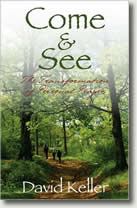Reclaiming Your True Self Through Prayer
We are people of patterns. We play out those patterns again and again in our lives, even when they are tiring or unhealthy. We play them out even while we are in the process of attempting to alter them. We may think we have dealt with some emotional issue in our life, only to find ourselves exhibiting the same behaviors and responses in another situation. We go to therapy, we read self-help books, we talk to friends and colleagues, we seek out life coaches, all in an effort to rid ourselves of the emotional baggage that is so pernicious. We want new patterns to be configured in us yet we wonder if we will ever break free from what keeps us bound.
We are not so unlike those individuals in Scripture who found themselves seeming victims of the vagaries of repetitive emotional responses. Consider Jacob, who couldn't break free of his need to deceive others because he was consumed with his own self-protection. Or, the elder brother in Jesus' story who couldn't let go of his resentment and anger against his younger brother. Or, the woman Jesus met at the well who struggled with fidelity and intimacy in her relationships. These problems are not so ancient that they have no bearing on us. Most of us are able to recognize the same difficulties in our own lives, and we know that the development of our soul is hindered by them.
Thomas Keating, Cistercian monk and master of prayer in the contemplative tradition addresses the reality of our human condition in the following video:
He discusses that a separate self sense develops in us as children and this separate self sense causes us to act and respond in predictable patterns that keep our soul from developing and resting in Divine Love. Even though we are designed for happiness, we seem to look for it in the wrong ways—in ways that keep us separated from the Other–from God. As children, we confuse happiness with gratification of instinctual needs. As we grow, the desire for security, power, control, affection, and esteem cause us to develop patterns of responses that are less than optimal. We carry this baggage right into adult life, and our ego causes us to get further and further away from our true self, while our false self continues to develop in separateness. As Keating humorously remarks, this makes transformation difficult since there are 6 billion others in the world doing the same thing!
We are not consigned to live like slaves to our false self. We do not need to rely on emotional programs for happiness that developed in us as children. Our true self waits to be discovered and claimed. There is a simple, but not easy, solution that will help lead us from our separateness to identification with the Holy. The practice of contemplative prayer has the capacity to place our soul into the sustained presence of divine love, where all the emotional baggage that we lug around inside our being can gradually be metabolized and shed. In the security of the divine presence, we can learn to let go of the emotional responses that keep us feeling like a rat in a trap, a fish in a bowl, a tiger in a cage.
As we engage in the practice of centering prayer, we simply notice when thoughts arise and begin to exert their seductive influence. We notice when feelings of boredom, anger, or resentment take over our mind-space. We notice when old hurts and past betrayals press upon us. We notice when existential dread and loss of faith disturb our peace. And, when we notice all these thoughts, we let them go. Centering prayer is the practice of letting go. We let thoughts go and renew our attention to the divine by recalling the sacred word as a symbol of our intent to be present to God.
The Dalai Lama, another master of contemplation writes, “The answer to every problem is meditation.” It may just be that when we learn how to let go in the presence of God, we will find ourselves letting go the next time we are ready to respond using the same tired emotional pattern that has held us captive for so long. What a moment of liberation that will be!
